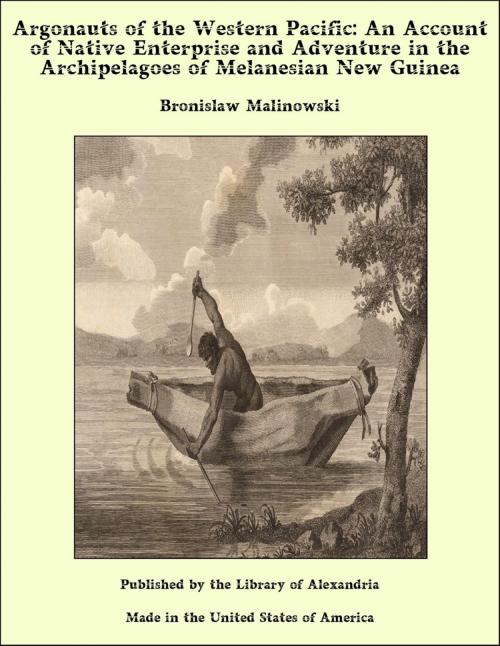Argonauts of the Western Pacific: An Account of Native Enterprise and Adventure in the Archipelagoes of Melanesian New Guinea
Nonfiction, Religion & Spirituality, New Age, History, Fiction & Literature| Author: | Bronislaw Malinowski | ISBN: | 9781465618085 |
| Publisher: | Library of Alexandria | Publication: | March 8, 2015 |
| Imprint: | Language: | English |
| Author: | Bronislaw Malinowski |
| ISBN: | 9781465618085 |
| Publisher: | Library of Alexandria |
| Publication: | March 8, 2015 |
| Imprint: | |
| Language: | English |
The coastal populations of the South Sea Islands, with very few exceptions, are, or were before their extinction, expert navigators and traders. Several of them had evolved excellent types of large sea-going canoes, and used to embark in them on distant trade expeditions or raids of war and conquest. The Papuo-Melanesians, who inhabit the coast and the out-lying islands of New Guinea, are no exception to this rule. In general they are daring sailors, industrious manufacturers, and keen traders. The manufacturing centres of important articles, such as pottery, stone implements, canoes, fine baskets, valued ornaments, are localised in several places, according to the skill of the inhabitants, their inherited tribal tradition, and special facilities offered by the district; thence they are traded over wide areas, sometimes travelling more than hundreds of miles. Definite forms of exchange along definite trade routes are to be found established between the various tribes. A most remarkable form of intertribal trade is that obtaining between the Motu of Port Moresby and the tribes of the Papuan Gulf. The Motu sail for hundreds of miles in heavy, unwieldy canoes, calledlakatoi, which are provided with the characteristic crab-claw sails. They bring pottery and shell ornaments, in olden days, stone blades, to Gulf Papuans, from whom they obtain in exchange sago and the heavy dug-outs, which are used afterwards by the Motu for the construction of their lakatoi canoes. Further East, on the South coast, there lives the industrious, sea-faring population of the Mailu, who link the East End of New Guinea with the central coast tribes by means of annual trading expeditions. Finally, the natives of the islands and archipelagoes, scattered around the East End, are in constant trading relations with one another. We possess in Professor Seligman’s book an excellent description of the subject, especially of the nearer trades routes between the various islands inhabited by the Southern Massim. There exists, however, another, a very extensive and highly complex trading system, embracing with its ramifications, not only the islands near the East End, but also the Louisiades, Woodlark Island, the Trobriand Archipelago, and the d’Entrecasteaux group; it penetrates into the mainland of New Guinea, and exerts an indirect influence over several outlying districts, such as Rossel Island, and some parts of the Northern and Southern coast of New Guinea. This trading system, the Kula, is the subject I am setting out to describe in this volume, and it will be seen that it is an economic phenomenon of considerable theoretical importance. It looms paramount in the tribal life of those natives who live within its circuit, and its importance is fully realised by the tribesmen themselves, whose ideas, ambitions, desires and vanities are very much bound up with the Kula.
The coastal populations of the South Sea Islands, with very few exceptions, are, or were before their extinction, expert navigators and traders. Several of them had evolved excellent types of large sea-going canoes, and used to embark in them on distant trade expeditions or raids of war and conquest. The Papuo-Melanesians, who inhabit the coast and the out-lying islands of New Guinea, are no exception to this rule. In general they are daring sailors, industrious manufacturers, and keen traders. The manufacturing centres of important articles, such as pottery, stone implements, canoes, fine baskets, valued ornaments, are localised in several places, according to the skill of the inhabitants, their inherited tribal tradition, and special facilities offered by the district; thence they are traded over wide areas, sometimes travelling more than hundreds of miles. Definite forms of exchange along definite trade routes are to be found established between the various tribes. A most remarkable form of intertribal trade is that obtaining between the Motu of Port Moresby and the tribes of the Papuan Gulf. The Motu sail for hundreds of miles in heavy, unwieldy canoes, calledlakatoi, which are provided with the characteristic crab-claw sails. They bring pottery and shell ornaments, in olden days, stone blades, to Gulf Papuans, from whom they obtain in exchange sago and the heavy dug-outs, which are used afterwards by the Motu for the construction of their lakatoi canoes. Further East, on the South coast, there lives the industrious, sea-faring population of the Mailu, who link the East End of New Guinea with the central coast tribes by means of annual trading expeditions. Finally, the natives of the islands and archipelagoes, scattered around the East End, are in constant trading relations with one another. We possess in Professor Seligman’s book an excellent description of the subject, especially of the nearer trades routes between the various islands inhabited by the Southern Massim. There exists, however, another, a very extensive and highly complex trading system, embracing with its ramifications, not only the islands near the East End, but also the Louisiades, Woodlark Island, the Trobriand Archipelago, and the d’Entrecasteaux group; it penetrates into the mainland of New Guinea, and exerts an indirect influence over several outlying districts, such as Rossel Island, and some parts of the Northern and Southern coast of New Guinea. This trading system, the Kula, is the subject I am setting out to describe in this volume, and it will be seen that it is an economic phenomenon of considerable theoretical importance. It looms paramount in the tribal life of those natives who live within its circuit, and its importance is fully realised by the tribesmen themselves, whose ideas, ambitions, desires and vanities are very much bound up with the Kula.















